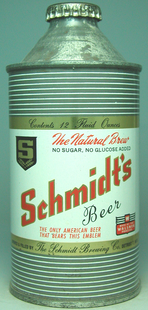Based on all sorts of my own past source material (brewer's ads and
newspaper clippings, "dump dating" and many years experience dealing
with the canning info on cans as clues), I can probably nail 90% of the
pre-1965 production dates within a year of actual. The following
Schmidt's flat top chronology is an example.
The first Schmidt flat top
(USBC 131-17)
came out just as E&B was in the process of absorbing Schmidt's in 1951.
That's the small-labeled flat that uses the Schmidt Brewing Company
mandatory. It's for all purposes identical to the cone
(USBC 184-10),
and both point readily to a period immediately following
the IRTP cusp. I'd call both the flat and the cone 1951 cans. The cone
was phased out, and the E&B mandatory appeared on the next version of
the flat
(USBC 131-18),
which is the similar multi-colored can with the larger label.
I think it's fair to call that one a 1952-1953 can.

|

|

|
| USBC 184-10 : 1951 | USBC 131-17 : 1951 | USBC 131-18 : 1952 |
The Schmidt label then appears to have been watered down to silver, white, and red (USBC 131-19) as evidenced on the "silver-trimmed" version, which is a 1953-1955 era label. I have a couple of theories as to why these cans evolved the way they did, although it's mostly guesswork on my part. The change from multi-colored lithography to a two-tone can on silver would seem to indicate that whoever wrote the checks at E&B was getting frugal. The simpler color scheme would have been cheaper to produce, albeit very similar (if not practically identical) in layout to the multi-colored label that preceded it. And, we have good reason to assume that E&B may have had some pre-existing impetus to cut costs: it's somewhat documented that E&B's takeover of Schmidt's may have been a last-ditch play to ward off their own bankruptcy!
Both companies were relatively strong in the 30's and 40's, but by 1950 they were both having difficulties. We can readily evidence the dramatic shift of marketing base in the post-1950 era, whereby the Schmidt's brand name was drawn in pretty close to Detroit and simultaneously expanded into northern Ohio. This took a competitor's label right out of the picture, so E&B was then free to push their own brand name in formerly lucrative Michigan markets sans competition from their former rival. The strategy looks to have kept them afloat for a few years, but the lifeboat had already sprung its leak and would not last for long. What's ironic is that the Schmidt's brand appears to have been as profitable (if not more so) in northern Ohio than E&B was destined to be right here at home!
I also have one other half-cracked notion about why the Schmidt's cans eventually lost their silver trim and basecoats - I think they may have been sitting around in carryout coolers for quite awhile and the metallics may well have been tarnishing in the process. So, what we get after the silver-trimmed can is the standard red-labeled can (USBC 131-20) with no trim around the brand name, ca. 1956 - 1958. The candy-striper (USBC 131-21) looks to have been an all-out effort at reducing litho costs, as it contains only two colors which would have served the dual purpose of cost-savings and of reducing the potential for cooler tarnish to almost nothing. A good thought there, but the brewer was destined to tank, anyhow. I believe the candy-striper to be the last in the series, very limited-run (I'm just venturing a guess at perhaps 4-6 months), and was probably available in extreme southern Michigan and northern Ohio in about 1958. The "dump record" tends to support this conclusion.

|

|

|
| USBC 131-19 : 1953 | USBC 131-20 : 1956 | USBC 131-21 : 1958 |
Then, everybody wonders about the "Superman" label (USBC 131-22). Bear in mind that it was probably produced in about 1962, roughly three to four years AFTER the last candy-striper was put out to pasture. Yes, there appears to have been a canning hiatus in the interim, during which time Schmidt's would only have been available in bottles and probably mostly in suburban markets. Also bear in mind that the Superman, despite the E&B Brewing Co mandatory, was an Associated Brewing Company can. It coincides well with the Associated takeover of Pfeiffer and Drewry's, as well - all three breweries were absorbed in the very early 1960's. E&B probably stopped canning Schmidt's after the candy-striper was pulled from the shelves, relegating their entire output to bottles from somewhere around 1958 until Associated sucked them up. It was always interesting to me that there were no primitive tab versions of the Superman out there, because it's almost a guarantee that they were being sold right alongside some early ziptabs at the retail level.
Of course, the final canned "Schmidt's" offering (the zip itself, BCU_116-31), is a drastic deviation from former design concepts. Rare as the split-label design is, it appears to have been produced in cans between about 1963 and 1965, give or take. It apparently wasn't a big seller, although it was a popular economy brand in bottles, particularly around Detroit. I've seen original bottles with the same split-label design bearing dates well into the mid-1960's, and have even talked to a few Detroit natives that remember the brand well from that time period.

|

|
| USBC 131-22 : 1962 | BCU_116-31 : 1963 |